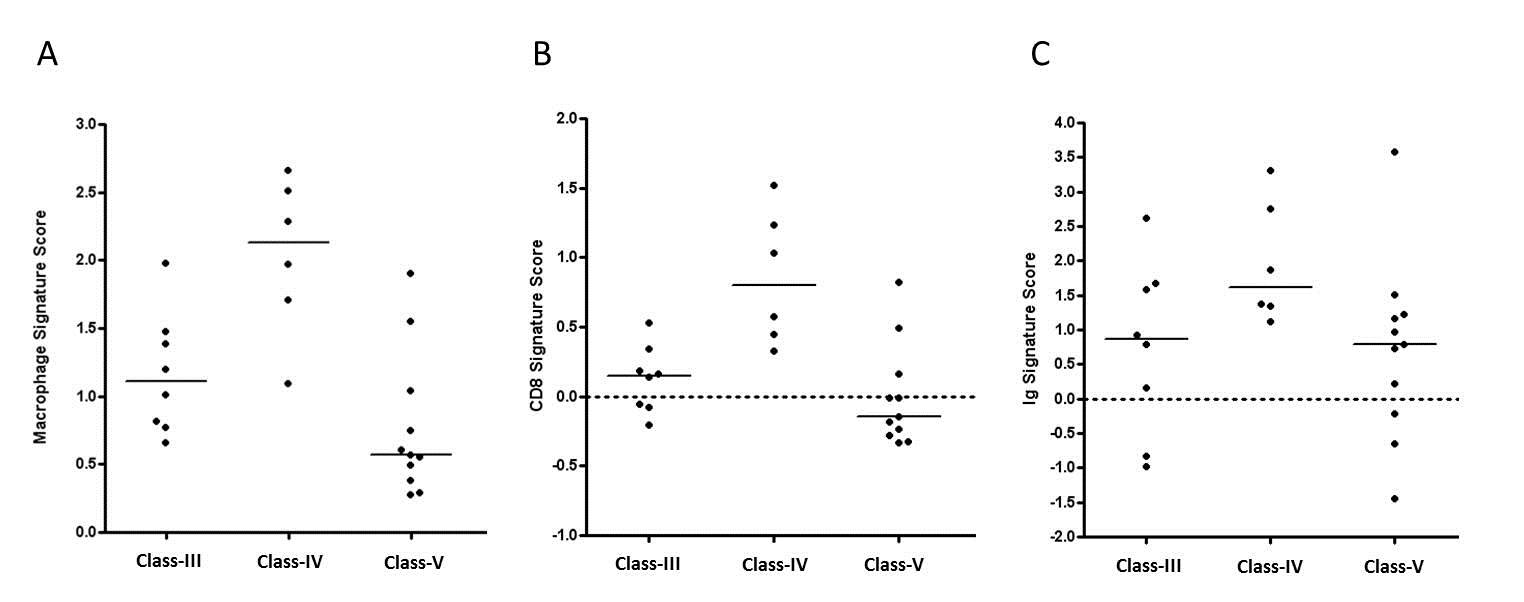Session Information
Session Type: Abstract Submissions (ACR)
Transcript profiling of kidney biopsies from Chinese patients with lupus nephritis suggests a prevalence of infiltrating CD8+ T cells, monocytes/macrophages, and B cells in ISN/RPS class IV disease
Background/Purpose: Lupus nephritis (LN) affects ~60% of patients with systemic lupus erythematosus (SLE). The International Society of Nephrology and the Renal Pathology Services (ISN/RPS) classification system categorizes LN into 6 main classes based on the underlying renal pathology. Among these, Classes I and II rarely require immunosuppressive treatment and Class-VI is associated with irreversible glomerulosclerosis. Class-IV (diffuse proliferative nephritis) is the most severe form with the largest proportion of all diagnosed cases (~40%) followed by Class-III (focal proliferative nephritis), representing ~25% of all diagnosed cases. These classes have similar histopathological and clinical characteristics while Class-V (membranous nephritis) representing ~10% of LN cases is different both in its clinical course and histological appearance. We examined kidney biopsies from a group of ISN/RPS Class III, IV, and V LN subjects to evaluate molecular differences between these classes.
Methods: Kidney biopsies were procured from 6 healthy donor (HD) and 25 LN (8 Class-III, 6 Class-IV, and 11 Class-V) Chinese subjects. The Affymetrix U133+ array was used to transcript profile specimens. Fold changes were calculated for each LN subject relative to the average HD expression. Previously defined cell type-specific gene signatures were identified to be differential between ISN/RPS classes.
Results: Several gene signatures were significantly over-expressed (p<0.05) in Class-IV subjects relative to both Class-III and -V subjects. These included: a chemokine, MHC class I, monocyte, macrophage, and CD8+ T cell gene signatures. An immunoglobulin (Ig) signature was also significantly over-expressed in Class-IV subjects compared to Class-V subjects, but not Class-III subjects. The following gene signatures did not significantly differ between the three classes: neutrophil, CD4+ T cell, and type I IFN.
Conclusion: Transcript profiling was used to correlate the molecular differences between LN disease classifications and cell infiltrate prevalence. In addition to pathways upregulated in all three forms of LN, we identified cell type-specific signatures which were over-expressed in Class-IV. The increased CD-8+ signature suggests that CD8+ effector T cell infiltration may correlate with more active disease status. Monocytes/macrophages are also more prevalent in this more active disease class, suggesting an increase in infiltration from damage caused by these CD8+ T effector cells, which may also lead to an increase in Ig products.
Figure 1. Distribution of A) macrophage, B) CD8+ T cell, and C) Ig gene signatures for LN patients with Class-III, -IV, or -V disease.
Disclosure:
Z. Liu,
MedImmune LLC,
3,
AstraZeneca,
1;
C. Morehouse,
Astra Zeneca,
1;
X. Huang,
None;
P. Brohawn,
MedImmune LLC,
3,
Astra Zeneca,
1;
N. Shen,
MedImmune,
5;
G. G. Illei,
AstraZeneca,
1,
MedImmune,
3;
Y. Yao,
None;
B. W. Higgs,
MedImmune LLC,
3,
AstraZeneca,
1.
« Back to 2013 ACR/ARHP Annual Meeting
ACR Meeting Abstracts - https://acrabstracts.org/abstract/transcript-profiling-of-kidney-biopsies-from-chinese-patients-with-lupus-nephritis-suggests-a-prevalence-of-infiltrating-cd8-t-cells-monocytesmacrophages-and-b-cells-in-isnrps-class-iv-disease/

